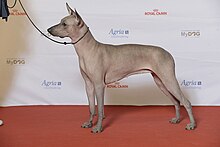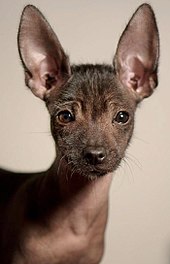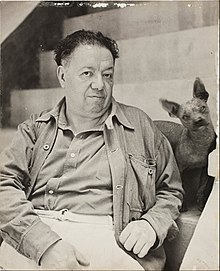Xoloitzcuintle
| Xoloitzcuintle | |||||||||
|---|---|---|---|---|---|---|---|---|---|
 A lighter-colored Xoloitzcuintle | |||||||||
| Other names | Xoloitzcuintle, Xoloitzquintle, Xoloitzcuintli | ||||||||
| Common nicknames | Xolo | ||||||||
| Origin | Mexico | ||||||||
| |||||||||
| |||||||||
| Notes | National dog of Mexico | ||||||||
| Dog (domestic dog) | |||||||||
The Xoloitzcuintle (or Xoloitzquintle, Xoloitzcuintli, or Xolo) is one of several breeds of hairless dog. It is found in standard, intermediate, and miniature sizes. The Xolo also comes in a coated variety, totally covered in fur. Coated and hairless can be born in the same litter as a result of the same combination of genes. The hairless variant is known as the Perro pelón mexicano or Mexican hairless dog.[1] It is characterized by its wrinkles and dental abnormalities, along with a primitive temper. In Nahuatl, from which its name originates, it is xōlōitzcuintli [ʃoːloːit͡sˈkʷint͡ɬi] (singular)[2] and xōlōitzcuintin [ʃoːloːit͡sˈkʷintin] (plural).[2] The name comes from the god Xolotl that, according to ancient narratives, is its creator and itzcuīntli [it͡sˈkʷiːnt͡ɬi], meaning 'dog' in the Nahuatl language.[2]
History
[edit]





Ceramic sculptures of a hairless breed of dog have been found in burial sites in ancient West Mexico.[4] In ancient times, Xolos were often sacrificed and then buried with their owners to act as guides to the soul on its journey to the underworld. They have been found in burial sites of both the Maya and the Toltec.[5]
Sixteenth-century Spanish accounts tell of large numbers of dogs being served at banquets.[6] Aztec merchant feasts could have 80–100 turkeys and 20–40 dogs served as food.[7] When these two meats were served in the same dish, the dog meat was at the bottom of the dish, possibly because it was held in lower regard.[7]
The Aztecs consumed few domesticated animals, with over 90% of the bones found at archeological sites being deer.[7]
Genetics
[edit]A 1999 genetic study using mitochondrial DNA found that the DNA sequences of the Xoloitzcuintle were identical to those of dogs from the Old World.[8] In 2018, an analysis of DNA from the entire genome indicated that domesticated dogs entered North America from Siberia for 4,500 years and were isolated for the next 9,000 years. After contact with Europeans, these dogs were replaced by Eurasian dogs and their local descendants. The pre-contact dogs exhibited a unique genetic signature that is now almost gone[9] due to their assimilation into the Eurasian dog gene pool. In 2020, the sequencing of ancient dog genome indicates that in two Mexican breeds the Chihuahua and Xoloitzcuintli derive 4% and 3% of their ancestry from pre-colonial dogs,[10] almost entirely being descended from Eurasian dogs.
Their phenotype is a consequence of canine ectodermal dysplasia caused by a mutation on the FOXI3 autosomal gene.[11]
Registry
[edit]Fédération Cynologique Internationale (FCI)
[edit]This section needs additional citations for verification. (March 2023) |
The breed did not receive any official notice in its homeland until the 1950s. The FCI, founded in 1940, was not prepared to declare the Xolo an official purebred at that time. According to breed historian Norman Pelham Wright, author of The Enigma of the Xoloitzcuintli, Xolos began to turn up at Mexican dog shows in the late 1940s. Although they were recognized as indigenous specimens of a native breed, interest in them was minimal at that time, because information was scarce and no standard existed by which to judge them. Within a decade, the FCI realized that the breed would become extinct if drastic action were not taken to save it. This led to the widely publicized Xolo Expedition of 1954. With the official sanction of the FCI, Wright and a team of Mexican and British dog authorities set off to discover if any purebred Xolos still existed in remote areas of Mexico.[citation needed] Eventually 10 structurally strong Xolos were found and these dogs formed the foundation of Mexico's program to revive the breed. A committee headed by Wright authored the first official standard for the breed; on May 1, 1956, the Xolo was finally recognized in its native land and, as Mexico is a member of the FCI, worldwide.[citation needed]
American Kennel Club (AKC)
[edit]Xolos were among the first breeds recorded by the American Kennel Club (AKC). A Mexican dog named "Mee Too" made breed history as the first AKC-registered Xolo in 1887. "Chinito Junior", bred and owned by Valetska Radtke of New York City, became the breed's only AKC champion to date. He earned his title on October 19, 1940.[12]
In 1959, the Xolo was dropped from the AKC stud book due to the breed's scarcity and perceived extinction. The Xoloitzcuintli Club of America (XCA), the official parent club for the breed, was founded on October 26, 1986, to regain AKC recognition for the breed. On May 13, 2008, AKC voted to readmit the breed to its Miscellaneous Class starting January 1, 2009. The founding members voted unanimously to recognize all three sizes (toy, miniature and standard) and both varieties (hairless and coated) at their initial meeting. Since then, the XCA has compiled a stud book modeled on requirements for eventual AKC acceptance, held an annual independent specialty show, published a quarterly newsletter, The Xolo News, and maintained an active national rescue network, National Xolo Rescue (known before 2009 as The Xolo Rescue League[13]). Since January 1, 2007, FSS registered Xolos have been eligible to compete in AKC performance events. The breed was moved into the AKC Studbook in December 2010 and has been eligible to be shown in the AKC Non-Sporting group since January 1, 2011.[14]
Characteristics
[edit]Appearance
[edit]The breed ranges in size from about 10 to 55 lb (5 to 23 kg). The height is 9 to 26 inches (23–67 cm). Similar in appearance to a Pharaoh Hound, with a sleek body, almond-shaped eyes, large bat-like ears, and a long neck, the Xolo is notable for its dominant trait of hairlessness.[15] The dominant hairless trait originated in this breed as a spontaneous mutation thousands of years ago. The recessive expression of the trait will produce a coated variety, which is genetically inseparable from the hairless, as the homozygous appearance of the hairless mutation is fatal to the unborn pup.[16] Most litters contain both hairless and coated puppies. The coated variety, covered with a short, flat dense coat represents the original form of the dog, prior to the occurrence of the spontaneous hairless mutation.[17] The hairless variety is completely hairless on the body, with many dogs exhibiting a few short hairs on the top of the head, the toes, and the tip of the tail. Most hairless dogs are black or bluish-gray in color. The allele responsible for the Xolo's hairlessness also affects the dog's dentition: Hairless Xolos typically have an incomplete set of teeth while the dogs of the coated variety have complete dentition.
The Xolo is moderate in all aspects of its appearance, conveying an impression of strength, agility, and elegance. Xolo body proportions are rectangular, slightly longer in total body length than the height measured at the highest point of the withers (top of the shoulders). The breed occurs naturally in two varieties, hairless and coated. Hairless Xolos result from the presence of the dominant allele (HH or Hh) at the FOXI3 locus.[18] Coated Xolo are the recessive expression, occurring only when two coated alleles (hh) are present. Breeding coated to coated will only produce coated pups because only the coated allele is present to be passed on.
Both varieties occur in all hair or skin colors, and the skin is often marked, splashed, or spotted. The most common colors are various shades termed black, grey, bronze, yellowish-blonde, blue and red. The breed occurs in a range of sizes, which breeders have standardized into three designations: Standard, Miniature and Toy.
The Xoloitzcuintle has a calm and attentive temperament.[19]
Health
[edit]The Xolo has been developed by natural selection for thousands of years, and is therefore generally not prone to health and structure problems as other dog breeds more modified by human selection efforts. Xolos came from tropical climates and are not suited for outdoor life in colder temperate and northern climates; they should be considered an indoor dog breed.[failed verification] They need bathing, light grooming and skin care as with other dogs of similar physical type, or acne can result. Most skin problems arise from poor breeding, neglect, or over-bathing and over-lotioning, stripping natural protections and clogging pores.[20][21]
In contemporary culture
[edit]Xoloitzcuintles are represented in popular culture and are popular pets.[22] Museo El Carmen in Mexico City exhibited a show titled Xolos, compañeros de viaje (Xolos, travel companions) in 2019–20 of more than 100 artifacts – ceramics, remains, and artworks – overviewing the importance of the Xoloitzcuintle in Mexican heritage.[23] A Xolo named Dante stars in the US blockbuster CGI animation 2017 Disney/Pixar film Coco.[22] On August 12, 2016, the Mayor of Mexico City Miguel Ángel Mancera designated the Xoloitzcuintle a "cultural heritage and symbol" of Mexico City.[24][25] The Dolores Olmedo Museum keeps a pack of Xolos on their grounds.[26]
The Xoloitzcuintle is the symbol and mascot of Club Tijuana, the Xoloitzcuintles de Caliente, a professional soccer club founded in 2007. Xolos are depicted in some of Mexican artist Frida Kahlo's paintings,[27] one of which is commemorated on the 2007 500-peso note, featuring Frida Kahlo's painting titled The Love Embrace of the Universe, the Earth (Mexico), Myself, Diego, and Señor Xolotl (1949) on the reverse of the note.[28] Diego Rivera's large murals, The History of Mexico, in the Palacio Nacional in Mexico City feature numerous Xolos.[29]
See also
[edit]References
[edit]- ^ FCI Breed Standard
- ^ a b c Nahuatl Dictionary. (1997). Wired Humanities Project. University of Oregon. Retrieved September 1, 2012, from link Archived 2016-12-03 at the Wayback Machine
- ^ a b "GCH Bayshore's Giorgio Armani Leads the Way for Xoloitzcuintli Breed". Purina ProClub. Retrieved 11 April 2015.
- ^ "vessel in form of a dog". Indianapolis Museum of Art Online Collection. Retrieved 2020-01-06.
- ^ "Mexico is in love with a $5,000 hairless dog that often wins competitions — in the ugliest category". Los Angeles Times. 2017-04-28. Retrieved 2020-01-06.
- ^ Coe, Sophie D. (1994) America's first cuisines ISBN 0-292-71159-X p112
- ^ a b c Aguilar-Moreno, M. (2006). Handbook to life in the Aztec world. Oxford University Press: USA. p. 329 ISBN 978-0-19-533083-0
- ^ Vila, C. (1 January 1999). "Phylogenetic relationships, evolution, and genetic diversity of the domestic dog". Journal of Heredity. 90 (1): 71–77. doi:10.1093/jhered/90.1.71. PMID 9987908.
- ^ Ní Leathlobhair, Máire; Perri, Angela R.; Irving-Pease, Evan K.; Witt, Kelsey E.; Linderholm, Anna; Haile, James; Lebrasseur, Ophelie; Ameen, Carly; Blick, Jeffrey; Boyko, Adam R.; Brace, Selina; Cortes, Yahaira Nunes; Crockford, Susan J.; Devault, Alison; Dimopoulos, Evangelos A.; Eldridge, Morley; Enk, Jacob; Gopalakrishnan, Shyam; Gori, Kevin; Grimes, Vaughan; Guiry, Eric; Hansen, Anders J.; Hulme-Beaman, Ardern; Johnson, John; Kitchen, Andrew; Kasparov, Aleksei K.; Kwon, Young-Mi; Nikolskiy, Pavel A.; Lope, Carlos Peraza; Manin, Aurélie; Martin, Terrance; Meyer, Michael; Myers, Kelsey Noack; Omura, Mark; Rouillard, Jean-Marie; Pavlova, Elena Y.; Sciulli, Paul; Sinding, Mikkel-Holger S.; Strakova, Andrea; Ivanova, Varvara V.; Widga, Christopher; Willerslev, Eske; Pitulko, Vladimir V.; Barnes, Ian; Gilbert, M. Thomas P.; Dobney, Keith M.; Malhi, Ripan S.; Murchison, Elizabeth P.; Larson, Greger; Frantz, Laurent A. F. (6 July 2018). "The evolutionary history of dogs in the Americas". Science. 361 (6397): 81–85. Bibcode:2018Sci...361...81N. doi:10.1126/science.aao4776. PMC 7116273. PMID 29976825. S2CID 206663458.
- ^ Bergström, Anders; Frantz, Laurent; Schmidt, Ryan; Ersmark, Erik; Lebrasseur, Ophelie; Girdland-Flink, Linus; Lin, Audrey T.; Storå, Jan; Sjögren, Karl-Göran; Anthony, David; Antipina, Ekaterina; Amiri, Sarieh; Bar-Oz, Guy; Bazaliiskii, Vladimir I.; Bulatović, Jelena; Brown, Dorcas; Carmagnini, Alberto; Davy, Tom; Fedorov, Sergey; Fiore, Ivana; Fulton, Deirdre; Germonpré, Mietje; Haile, James; Irving-Pease, Evan K.; Jamieson, Alexandra; Janssens, Luc; Kirillova, Irina; Horwitz, Liora Kolska; Kuzmanovic-Cvetković, Julka; Kuzmin, Yaroslav; Losey, Robert J.; Dizdar, Daria Ložnjak; Mashkour, Marjan; Novak, Mario; Onar, Vedat; Orton, David; Pasaric, Maja; Radivojevic, Miljana; Rajkovic, Dragana; Roberts, Benjamin; Ryan, Hannah; Sablin, Mikhail (2020). "Origins and genetic legacy of prehistoric dogs". Science. 370 (6516): 557–564. doi:10.1126/science.aba9572. PMC 7116352. PMID 33122379. S2CID 225956269.
- ^ Manin, Aurélie; Ollivier, Morgane; Bastian, Fabiola; Zazzo, Antoine; Tombret, Olivier; Equihua Manrique, Juan Carlos; Lefèvre, Christine (October 2018). "Can we identify the Mexican hairless dog in the archaeological record? Morphological and genetic insights from Tizayuca, Basin of Mexico" (PDF). Journal of Archaeological Science. 98: 128–136. Bibcode:2018JArSc..98..128M. doi:10.1016/j.jas.2018.08.008. S2CID 135348745.
- ^ "Xoloitzcuintli Dog Breed Information". American Kennel Club. Retrieved 2023-04-21.
- ^ National Xolo Rescue Archived June 26, 2010, at the Wayback Machine at the XCA website
- ^ Xolo News Archived 2010-01-13 at the Wayback Machine at AKC.org
- ^ Kimura, T.; Ohshima, S.; Doi, K. (1 January 1993). "The inheritance and breeding results of hairless descendants of Mexican hairless dogs". Laboratory Animals. 27 (1): 55–58. doi:10.1258/002367793781082403. PMID 8437436. S2CID 21822477.
- ^ "FCI-Standard N° 234: XOLOITZCUINTLE (Hairless Variety & Coated Variety)". Fédération Cynologique Internationale. 2011-02-16. Archived from the original on 2013-11-01. Retrieved 2012-08-20.
- ^ "xoloitzcuintliclubofamerica.com". Archived from the original on May 27, 2008.
- ^ Drögemüller, Cord; Karlsson, Elinor K.; Hytönen, Marjo K.; Perloski, Michele; Dolf, Gaudenz; Sainio, Kirsi; Lohi, Hannes; Lindblad-Toh, Kerstin; Leeb, Tosso (12 September 2008). "A Mutation in Hairless Dogs Implicates FOXI3 in Ectodermal Development". Science. 321 (5895): 1462. Bibcode:2008Sci...321.1462D. doi:10.1126/science.1162525. PMID 18787161. S2CID 206514824.
- ^ "Official Standard of the Xoloitzcuintli" (PDF). American Kennel Club. 2004-06-20. Retrieved 2023-09-25.
- ^ Kimura, Tohru; Doi, Kunio (1996). "Spontaneous Comedones on the Skin of Hairless Descendants of Mexican Hairless Dogs". Experimental Animals. 45 (4): 377–384. doi:10.1538/expanim.45.377. PMID 8902502.
- ^ Kimura, Tohru (1996). "Studies on Development of Hairless Descendants of Mexican Hairless Dogs and Their Usefulness in Dermatological Science". Experimental Animals. 45 (1): 1–13. doi:10.1538/expanim.45.1. PMID 8689575.
- ^ a b Serrato, Jacqueline (17 November 2017). "Aztec dog gains popularity in US after 'Coco'". chicagotribune.com. Retrieved 2020-10-23.
- ^ "Museo de El Carmen inaugura expo sobre los xolos por el Día de Muertos". www.milenio.com. 17 October 2019. Retrieved 2020-01-07.
- ^ "Xoloitzcuintle patrimonio de la CDMX", El Universal, August 12, 2016
- ^ "Xoloitzcuintle, el perro azteca, patrimonio de la CDMX". Excélsior (in Spanish). 2016-08-12. Retrieved 2020-01-06.
- ^ "Museo Dolores Olmedo y sus xoloitzcuintles: todo lo que debes saber antes de visitarlo". El Universal (in Spanish). 2019-11-04. Retrieved 2020-10-23.
- ^ "Frida Kahlo and her Itzcuintli Dogs".
- ^ "Presentación del nuevo billete de quinientos pesos" (PDF). Bank of Mexico. Archived from the original (PDF) on 23 September 2010. Retrieved 11 September 2010.
- ^ Rivera, Luis-Martin Lozano & Juan Rafael Coronel. Diego Rivera The Complete Murals. Italy: TASCHEN GmbH, 2008. Print
Further reading
[edit]- The Xolo Handbook. Xoloitzcuintli Club of America, 1999.
- Parker, Heidi G.; Harris, Alexander; Dreger, Dayna L.; Davis, Brian W.; Ostrander, Elaine A. (5 February 2017). "The bald and the beautiful: hairlessness in domestic dog breeds". Philosophical Transactions of the Royal Society B: Biological Sciences. 372 (1713). doi:10.1098/rstb.2015.0488. PMC 5182420. PMID 27994129.
